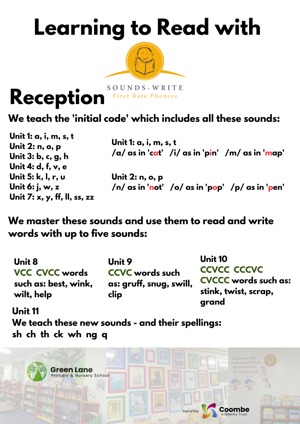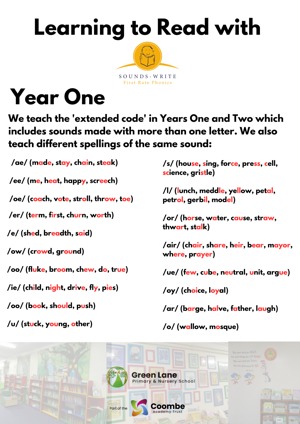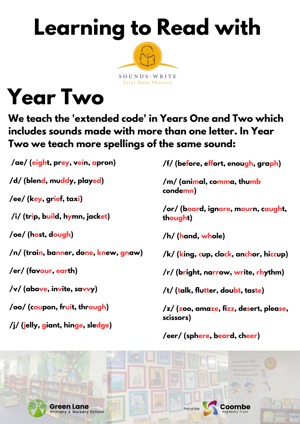- Home
- Learning
- Reading and Phonics
Reading and Phonics
Reading
At Green Lane, we awaken the inner reader in every child. We recognise that learning to read unlocks unlimited possibilities so from their very first day with us in Nursery, our pupils are given the skills to enable them to decode and understand language to ensure that they become independent, confident and fluent readers at the earliest possible stage.
'To learn to read is to light a fire; every syllable that is spelled out is a spark.’- Victor Hugo
‘There’s no such thing as a child who hates to read; there are only children who have not found the right book- yet.’- Frank Serafini ‘
‘Once you learn to read, you will be forever free.’- Frederick Dougglas
Every one of our pupils will grow into life-long readers who take pleasure in learning from, or escaping in, a great book every day in school and at home. At our school, our children are surrounded by a plethora of engaging, informative, enjoyable and challenging texts across the curriculum and have access to stimulating reading environments which promote and celebrate a passion for reading. All our children enjoy the pleasure of being read to everyday. They are guided in finding and choosing books that they love as well as being introduced to exciting new authors, poets and topics to broaden and enrich their reading diet.
‘Reading changes your life. Reading unlocks worlds unknown or forgotten, taking travellers around the world and through time. Reading helps you escape the confines of school and pursue your own education. Through characters – the saints and the sinners, real or imagined – reading shows you how to be a better human being.’- Donalyn Miller
Throughout our curriculum, our pupils read, comprehend, interpret and respond to texts that inspire them, educate them, enrich their vocabulary, challenge their thinking, make them laugh, make them cry and most importantly, teach them to understand, empathise with and value different cultures, traditions and opinions- real or imagined.
At GLPNS, children take home reading books each week from when they are ready in Reception and then throughout their time with us right up to Year 6.
Our Reading Schemes:
- Sounds-Write
- Dandelion Readers
Phonics
At Green Lane Primary and Nursery School, we use the Sounds-Write phonics programme to teach our children to read, spell and write.
Sounds-Write is effective in teaching pupils to read, spell and write because it starts from what all children know from a very early age – the sounds of their own language. From there, it takes them in carefully sequenced, incremental steps and teaches them how each of the 44 or so sounds in the English language can be spelt.
The four key concepts children need to learn are:
-
Letters are symbols that represent sounds
-
Sounds can be spelled using 1, 2, 3 or 4 letters
-
The same sound can be spelled in different ways
-
The same spelling can represent different sounds
The three keys skills children need to master are:
-
Blending
-
Segmenting
-
Phoneme Manipulation
From Nursery to Year 2, children will be taught phonics on a daily basis. At the start of the programme only one sound/one spelling, one-syllable and CVC words are introduced. For example: s-a-m
Children learn the sounds then blend them together to read a word. To spell, children are taught to say the word, segment it into the smallest sounds then write it.
Children are also taught to read (by sight) and spell high frequency words. These are words that they commonly find in the books they read.
A multi-sensory approach is used with visual, auditory and kinaesthetic activities combined simultaneously to promote learning. In addition to being multi-sensory, the Sounds-Write programme has pace and utilises an array of stimulating lessons and resources. It also enables differentiation with challenges placed before the children in order to meet their individual needs.
Nursery and Reception
Support the importance of speaking and listening and develop children’s discrimination of sounds, including letter sounds. Children in our Foundation Stage begin with the Initial Code where they practice all 3 key skills whilst learning the 1:1 sound-spelling correspondences and securing their understanding of key concept 1. This builds up trust in a truly reversible system, enabling them to decode and encode a wide range of words and sentences. At first, children learn to read and write simple one syllable words with a CVC structure. Complexity of word structure systematically builds up so that children apply their code knowledge to monosyllabic words with up to 6 sounds.
The initial code
Unit 1-6
Children begin by learning that sounds/phonemes are represented by symbols/spelling, beginning with single letters.
Units 1-6 : a, i, m, s, t, n, o, p, b, c, g, h, d, e, f, v, k, l, r, u, j, w, z
Unit 7
Children tackle , which is an anomaly, in that it is a letter that codes for two sounds. The idea of two letter spelling are also introduced.
Unit 7: x, y, ff, ll, ss, zz
Units 8 to 10
Here the children are supported to deal with longer words consisting of four and five sounds that can involve up to three consecutive consonants e.g ‘strip’ and ‘jumps’
Unit 11
The initial code finishes here with the children being taught to extend the idea that two-letter spelling can represent one sound.
Unit 11: sh, ch, th, ck, wh, ng, qu
Extended Code
Once the Initial Code has been mastered, children continue to practice all 3 key skills whilst learning Extended Code which explores key concepts 2, 3 and 4. Learning of the Extended Code is a lifelong process – we all continue to develop our understanding of this code whenever we encounter new words! Whilst learning the Extended Code, children read and write monosyllabic and polysyllabic words at an age-appropriate level.
Within extended code lessons children will focus on the phonemic nature of the code (sounds) and its graphemic nature (spellings)
Lessons 6-9: Sounds - The main object is to teach the sound and the various ways the spelling can be spelled e.g. the /ae/ can be spelled , , , etc


